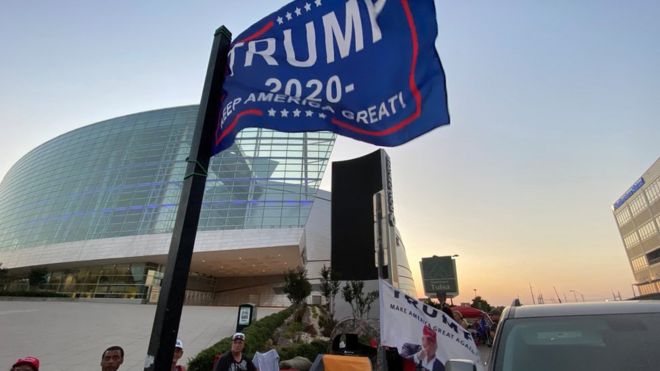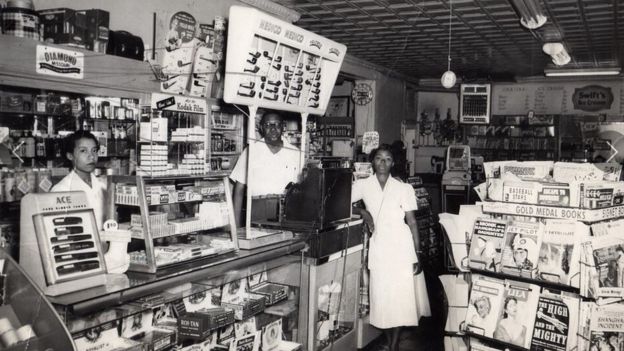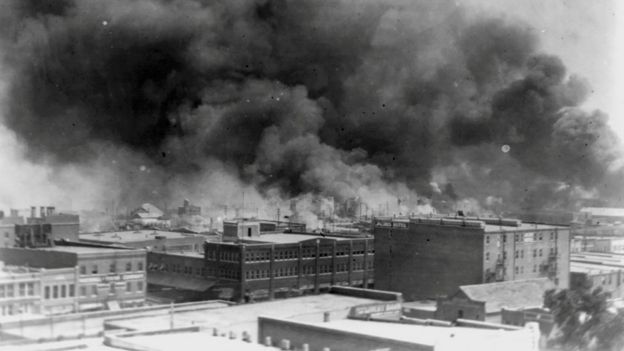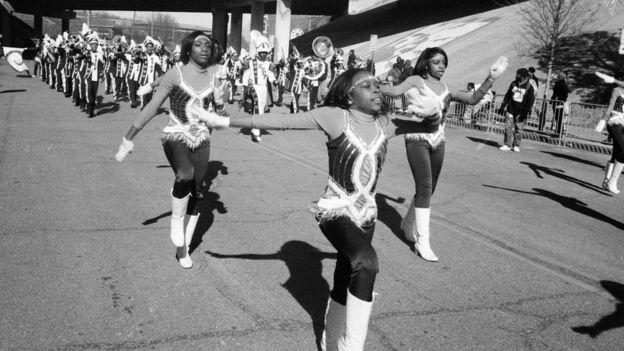
President Donald Trump is holding his first political rally since the start of the pandemic in Tulsa, Oklahoma, this weekend. His choice of location and the date have raised tensions in a city struggling to come to terms with its history of violent racism.
On 1 June 1921, a white mob ransacked the prosperous black neighbourhood of Greenwood, killing an estimated 300 people and burning 35 blocks of homes and businesses to the ground.
The bodies of the victims were buried in mass graves and, for decades, the memory of those fearful first few days in June were buried with them.
“Following the massacre, both blacks and whites swept this under the rug,” says Mechelle Brown, programme co-ordinator at the Greenwood Cultural Center, which preserves the history of the neighbourhood.
“They had to focus on surviving. They said that to talk about it meant to relive it, and it was too painful to relive.”
The killing started after a young black man was accused of assaulting a young white girl in a downtown office elevator.
 I
IThe man, Dick Rowland, was arrested and there were fears he would be lynched. A group of African Americans went to the jail to protect him and were confronted by a larger group of white men. Shots were fired and the ensuing violence lasted for several days.
Thousands of white men, some of them deputised by the police, descended on Greenwood. Ten thousand people were forced from their homes. Others were murdered. Eyewitnesses said planes circled overhead dropping bombs of turpentine or coal oil while buildings were torched from the ground.
It remains the deadliest single act of racial violence in American history.
Nobody was ever charged in the looting and destruction and city officials who stood by – or took part – were never held accountable for failing to protect their black residents.
A commission has been set up to locate the graves and identify the victims – although a test excavation at one of the sites has been postponed because of the coronavirus pandemic. Emphasis has been placed on education with plans to teach the history of Greenwood in all Oklahoma state schools. And the neighbourhood is being promoted as a cultural and tourism destination.
Oklahoma’s Republican governor Kevin Stitt has invited Mr Trump and Vice-President Mike Pence to tour Greenwood ahead of Saturday’s rally – a move that has infuriated many residents.

The president has been widely accused of inflammatory rhetoric and of fuelling racial divisions during protests after George Floyd, an unarmed black man, was killed by a white police officer in Minneapolis last month. He has called for a law and order crackdown that critics say hasn’t addressed the concerns of peaceful protesters.
Some Tulsa residents say the president’s visit to Greenwood would be disrespectful and increase the risk of spreading the coronavirus within a vulnerable community. Statistics show that the death toll among African Americans is disproportionately higher than among white people.
“We are very concerned about all these people coming into our state as well as being escorted into our community to visit the Greenwood Cultural Center. That’s like bringing them right onto our house,” says TheRese Adunis, whose grandparents survived the Tulsa Race Massacre and whose father was born a few months later.
“Because we’re coming up on the 100th anniversary of the massacre, Greenwood is a hot tourist stop right now. Our city and our state want to promote it but it’s like, you want to make money and you want to be known for our misery but you don’t care about our lives,” she says.
She’s also angry that despite repeated promises no reparations have ever been paid to the survivors of the massacre and little has been done to reduce social and economic disparities within the city.
Before the massacre, Greenwood was known as Black Wall Street, the richest African-American neighbourhood in America, with some 300 black-owned businesses.
It was a centre for jazz and blues that profoundly influenced the music legend Count Basie. Apart from a handful of historic markers, there is little evidence of that prosperity today. The north side of Tulsa, with its population of 65,000 African Americans, remains separated by railway tracks from the predominantly white and richer south side of the city.
“They want to take credit for talking about it instead of taking ownership and fixing it,” says Damario Solomon Simmons, a lawyer and activist in Tulsa who has represented some of the survivors.

He’ll be taking part in a rally with the Rev Al Sharpton on June 19th, a date also known as Juneteenth, a national commemoration of the end of slavery in the US.
President Trump had planned to hold his campaign rally on Juneteenth but postponed it by a day following local protests.
“It’s an opportunity to leverage the history of Greenwood and the massacre for his own benefit,” says Mr Solomon Simmons. “That’s what we’re seeing throughout the city – powerful people who are utilising the history to push their agenda and give cover to their gentrification efforts.”
After the 1921 massacre, Greenwood residents rebuilt their community without aid or money from the state. For a while it flourished, but never fully recovered and eventually declined.
 \
\Mr Solomon Simmons says the death of George Floyd has sparked a new awareness of the ongoing inequalities and injustices facing African Americans.
“We who are advocating for legislation, we have to redouble our efforts. The time is now. I can’t imagine a better time with the whole world watching,” he says.

Comments
History repeats itself
Over and over again
We must learn from its mistakes by not
repeating or repeating and expect different
results.
Que sera sera
Kamtan
Facebook has removed a number of posts and ads run by Donald Trump’s re-election campaign for violating its “policy against organized hate”. The ads featured a symbol used by the Nazis.
The takedown came amid increasing pressure on Facebook from civil rights leaders, Democratic politicians, and the company’s own employees to take a stronger stance against the president’s ugly and at times violent and hateful rhetoric on the platform, though it is not the first time that Facebook has removed Trump campaign ads for violating policies.
Trump and his campaign have repeatedly made false assertions about “antifa”, a term that refers to loose networks of left-wing activists opposed to fascism and white nationalism.
There appears to be no evidence that antifa organizations were involved in incidences of rioting during the recent protests against the alleged police murder of George Floyd.
The inverted red triangle was a symbol used by the Nazis to identify political prisoners in concentration camps during the Holocaust.
Bend the Arc, a progressive Jewish activist organization, drew attention to the ads on Twitter writing:
“The President of the United States is campaigning for re-election using a Nazi concentration camp symbol … Trump and the RNC are using it to smear millions of protesters. Their masks are off.”
Americans, forget about China. You need to fight for survival against your own government and those who are behind the government,Democrats, republicans and others. If you don’t, China wouldn’t even matter.
Reporting from David Smith | The Guardian UK
Donald Trump declared “the silent majority is stronger than ever before” at his comeback rally on Saturday, but thousands of empty seats appeared to tell a different story.
The US president’s much hyped return to the campaign trail turned to humiliation when he failed to fill a 19,000-capacity arena in the Republican stronghold of Oklahoma, raising fresh doubts about his chances of winning re-election.
“The Emperor has no crowd,” tweeted Dan Pfeiffer, a former senior adviser to Barack Obama.
The overwhelmingly white gathering at Trump’s first rally since March was dwarfed by the huge multiracial crowds that have marched for Black Lives Matter across the country in recent weeks, reinforcing criticism that the president is badly out of step with the national mood.
The flop in Tulsa was an unexpected anticlimax for an event that seemed to offer a combustible mix of Trump, protests over racial injustice and a coronavirus pandemic that has killed nearly 120,000 Americans and put more than 40-million out of work.
First, Trump’s planned speech to an overflow event outside the venue was cancelled due to lack of attendance. Cable news networks showed a “Trump” lectern standing idle as workers dismantled a stage.
Then the rally venue itself was estimated to be only two-thirds full, with numerous empty seats in the upper tier and empty space on the area floor, despite his campaign having claimed that it received more than a million ticket requests. One explanation for the disconnect spread rapidly online as Twitter users suggested many of the requests were fakes filed by bored teens and even fans of Korean pop music playing a prank on the US president.
But to Trump officials Oklahoma had surely seemed a safe bet for the so-called “transition to greatness” event; Trump had defeated Hillary Clinton 65% to 29% in 2016. Yet the plan began to unravel when the rally, originally scheduled for Friday, was moved back a day following criticism that it would have clashed with Juneteenth, and in a city where in 1921 white supremacists killed an estimated 300 black residents.
The Trump campaign was also condemned for ignoring warnings from public health experts about the dangers of holding the biggest indoor gathering yet seen during the pandemic. Oklahoma has seen a 91% jump in its coronavirus cases over the past week. SIX STAFF MEMBERS WHO HELPED SET UP THE EVENT TESTED POSITIVE and there were fewer face masks among supporters than “Make America great again” signs.
The president appeared to trivialise the virus, “Testing is a double-edged sword,” he told the rally. “We’ve tested now 25 million people. It’s probably 20 million people more than anybody else. Germany’s done a lot. South Korea’s done a lot. Here’s the bad part, When you do testing to that extent, you’re going to find more people. You’re going to find more cases. So I said to my people, ‘Slow the testing down, please!’”
He also mused that COVID-19 has many different names, including the racist term “kung flu”. The crowd cheered.
It was a characteristic moment in a rambling speech that lasted nearly two hours but never caught fire. Trump offered few surprises, planting himself firmly on the side of law and order, LAMBASTING THE MEDIA AND STOKING DIVISION, HATRED AND FEAR.
“The silent majority is stronger than ever before,” he insisted, echoing the former president Richard Nixon. “Five months from now we’re going to defeat Sleepy Joe Biden. We are the party of Abraham Lincoln and we are the party of law and order.”
Warning against defunding police, he said: “It’s one in the morning, and a very tough – I used the word on occasion – hombre is breaking into the window of a young woman whose husband is away as a traveling salesman or whatever he may do. And you call 911 and they say, ‘I’m sorry this number is no longer working.’”
Trump, who has faced withering attacks for his response to the protests, which included threatening to deploy the US military, claimed: “I’ve done more for the black community in four years than Joe Biden has done in 47 years.”
But he offered no compassion for George Floyd or thousands of protesters who have taken to the streets against police brutality. Instead he railed against the recent removals of Confederate statues.
“The unhinged left-wing mob is trying to vandalize our history, desecrating our monuments, our beautiful monuments, tear down our statues and punish, cancel and persecute anyone who does not conform to their demands for absolute and total control, we’re not conforming,” he said.
Trump also took some long digressions. Clearly stung by media coverage of his slow, faltering walk down a ramp at the graduation ceremony for the US military academy at West Point last week, he riffed about it being steep and his slippery leather-soled shoes putting him at risk of falling in front of the cameras.
The low turnout will be a blow to Trump, whose campaign reportedly saw it as a way to revive his flagging spirits amid slumping poll numbers. The president had said last Monday: “ We’ve never had an empty seat. And we certainly won’t in Oklahoma.”
But confronted by empty seats that may prove more telling than any opinion poll, Trump hailed his supporters as “warriors” and blamed protesters for the poor turnout: “We had some very bad people outside. They were doing bad things.” He also described them as a “bunch of maniacs”.
The Trump campaign separately claimed that protesters interfered with the president’s supporters, even blocking access to the metal detectors, which prevented people from entering the rally. But multiple reporters on the ground saw no evidence of this.
Rallies are Trump’s lifeblood. As usual, this one ended with the Rolling Stones’ “You Can’t Always Get What You Want.”